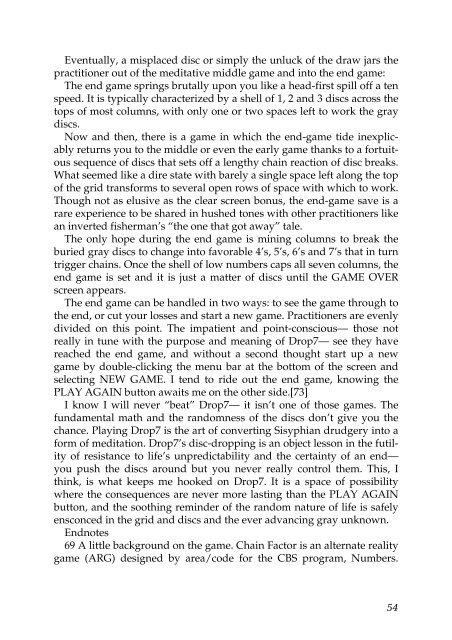Well Played 2.0: Video Games, Value and Meaning - OpenLibra
Well Played 2.0: Video Games, Value and Meaning - OpenLibra
Well Played 2.0: Video Games, Value and Meaning - OpenLibra
Create successful ePaper yourself
Turn your PDF publications into a flip-book with our unique Google optimized e-Paper software.
Eventually, a misplaced disc or simply the unluck of the draw jars the<br />
practitioner out of the meditative middle game <strong>and</strong> into the end game:<br />
The end game springs brutally upon you like a head-first spill off a ten<br />
speed. It is typically characterized by a shell of 1, 2 <strong>and</strong> 3 discs across the<br />
tops of most columns, with only one or two spaces left to work the gray<br />
discs.<br />
Now <strong>and</strong> then, there is a game in which the end-game tide inexplicably<br />
returns you to the middle or even the early game thanks to a fortuitous<br />
sequence of discs that sets off a lengthy chain reaction of disc breaks.<br />
What seemed like a dire state with barely a single space left along the top<br />
of the grid transforms to several open rows of space with which to work.<br />
Though not as elusive as the clear screen bonus, the end-game save is a<br />
rare experience to be shared in hushed tones with other practitioners like<br />
an inverted fisherman’s “the one that got away” tale.<br />
The only hope during the end game is mining columns to break the<br />
buried gray discs to change into favorable 4’s, 5’s, 6’s <strong>and</strong> 7’s that in turn<br />
trigger chains. Once the shell of low numbers caps all seven columns, the<br />
end game is set <strong>and</strong> it is just a matter of discs until the GAME OVER<br />
screen appears.<br />
The end game can be h<strong>and</strong>led in two ways: to see the game through to<br />
the end, or cut your losses <strong>and</strong> start a new game. Practitioners are evenly<br />
divided on this point. The impatient <strong>and</strong> point-conscious— those not<br />
really in tune with the purpose <strong>and</strong> meaning of Drop7— see they have<br />
reached the end game, <strong>and</strong> without a second thought start up a new<br />
game by double-clicking the menu bar at the bottom of the screen <strong>and</strong><br />
selecting NEW GAME. I tend to ride out the end game, knowing the<br />
PLAY AGAIN button awaits me on the other side.[73]<br />
I know I will never “beat” Drop7— it isn’t one of those games. The<br />
fundamental math <strong>and</strong> the r<strong>and</strong>omness of the discs don’t give you the<br />
chance. Playing Drop7 is the art of converting Sisyphian drudgery into a<br />
form of meditation. Drop7’s disc-dropping is an object lesson in the futility<br />
of resistance to life’s unpredictability <strong>and</strong> the certainty of an end—<br />
you push the discs around but you never really control them. This, I<br />
think, is what keeps me hooked on Drop7. It is a space of possibility<br />
where the consequences are never more lasting than the PLAY AGAIN<br />
button, <strong>and</strong> the soothing reminder of the r<strong>and</strong>om nature of life is safely<br />
ensconced in the grid <strong>and</strong> discs <strong>and</strong> the ever advancing gray unknown.<br />
Endnotes<br />
69 A little background on the game. Chain Factor is an alternate reality<br />
game (ARG) designed by area/code for the CBS program, Numbers.<br />
54

















